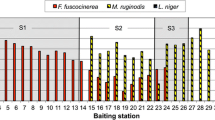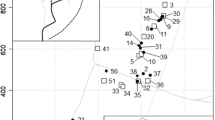Abstract
The Argentine ant, Linepithema humile, originally from South America, is now a major pest in many parts of the world with Mediterranean-like climates. Earlier research indicated that southwestern European L. humile populations are segregated into two distinct supercolonies, the ‘Main’ supercolony extending through Portugal, Spain, southern France, and Italy, and the ‘Catalonian’ supercolony in eastern Spain. Both supercolonies are unicolonial, with workers showing no aggression towards members of the same supercolony, but severe aggression towards members of the other supercolony. Here we evaluated the behavioral relationships among non-native L. humile populations on the Macaronesian islands of Madeira and the Azores and non-native populations in southwestern Europe. We conducted aggression assays among L. humile workers from Madeira, the Azores, and the two southwestern European supercolonies. We found no aggressive interactions among any combination of workers from Madeira, the Azores, and the Main supercolony. However, workers from Madeira and the Azores always fought aggressively with workers from the Catalonian supercolony. Thus, the populations of L. humile in Madeira and the Azores appear to be unicolonial and act as if they belong to the Main supercolony of southwestern Europe. This set of geographically separated but mutually compatible supercolonies, which we term a ‘metacolony,’ appears to descend from one supercolony. Historical evidence suggests that the first L. humile population in the greater Mediterranean region was established in Madeira and that propagules from the dominant supercolony in Madeira gave rise to the dominant supercolonies in to other parts of the region.
Similar content being viewed by others
References
Baroni Urbani C (1968). Studi sulla mirmecofauna d’Italia. IV. La fauna mirmecologica delle isole Maltesi ed il suo significato ecologico e biogeografico. Annali del Museo Civico di Storia Naturale “Giacomo Doria” 77: 408–559
Bernard F (1968). Faune de l’Europe et du Bassin Méditerranéen. 3. Les fourmis (Hymenoptera Formicidae) d’Europe occidentale et septentrionale. Masson, Paris
Buczowsk G, Vargo EL and Silverman J (2004). The diminutive supercolony: the Argentine ants of the southeastern United States. Molecular Ecology 13: 2235–2242
Casevitz-Weulersse J (1974). Premières données pour une étude écologique des fourmis de la Corse. Bulletin d’Ecologie 5: 55–70
Chopard L (1921). La fourmi d’Argentine Iridomyrmex humilis var. arrogans Santschi dans le midi de la France. Annales des Epiphyties 7: 237–265
Coutinho MP (1929). A “formiga argentina” “Iridomyrmex humilis” Mayr “var. arrogans”, Santschi. Boletim do ␣Ministério da Agricultura, Ano XI(13–18): 95–116
Donisthorpe H (1927). The ants (Formicidae) and some myrmecophiles, of Sicily. Entomological Record and Journal of Variation 39: 6–9
(1952). The Argentine ant Iridomyrmex humilis (Mayr). Farming in South Africa 54: 381–384
Espadaler X (2005) The ants of El Hierro (Hymenoptera, Formicidae). Memoirs of the American Entomological Institute 78, in press
Forel A (1895). Südpalaearctische Ameisen. Mitteilungen der Schweizerischen Entomologischen Gessellschaft 9: 227–234
García-Mercet R (1923). Sobre la Icerya purchasi y la hormiga argentina. Bolletin de la Real Sociedad Española de Historia Natural 23: 14–15
Giraud T, Pedersen JS and Keller L (2002). Evolution of supercolonies: the Argentine ants of southern Europe. Proceedings of the National Academy of Science 99: 6075–6079
Heller NE (2004). Colony structure in introduced and native populations of the invasive Argentine ant, Linepithema humile. Insectes Sociaux 51: 378–386
Hölldobler B and Wilson EO (1990) The Ants.Harvard University Press, Cambridge, Massachusetts
Holway DA, Suarez AV and Case TJ (1998). Loss of intraspecific aggression in the success of a widespread invasive social insect. Science 282: 949–952
Human KG and Gordon DM (1997). Effects of Argentine ants on invertebrate biodiversity in Northern California. Conservation Biology 11: 1242–1248
Krieger MJB and Keller L (1999). Low polymorphism at 19 microsatellite loci in a French population of Argentine ants (Linepithema humile). Molecular Ecology 8: 1082–1084
Kutter H (1981). Iridomyrmex humilis Mayr (Hym., Formicidae), Gattung und Art neu für die Schweiz. Mitteilungen der Schweizerischen Entomologischen Gessellschaft 54: 171–172
Le Breton J, Delabie JHC, Chazeau J, Dejean A and Jourdan H (2004). Experimental evidence of large-scale unicoloniality in the tramp ant Wasmannia auropunctata (Roger). Journal of Insect Behavior 17: 263–271
Martins MN (1907). Une fourmi terrible envahissant l’Europe (Iridomyrmex humilis Mayr). Brotéria, Series Zoología 6: 101–102
Mayr G (1868). Formicidae novae Americanae collectae a Prof. P. de Strobel. Annuario della Società dei Naturalisti e Matematici, Modena 3: 161–178
Novák V (1947). Exotictí mravenci ve sklenících Prazské botanické zahrady. Acta Societatis Entomologicae Cechoslovenicae 44: 144–146
Pasfield G (1968). Argentine ants. Australian Natural History 16: 12–15
Pax F (1915). Beobachtungen über das Auftreten der “argentinischen Ameisen,” Iridomyrmex humilis Mayr, in Schlesien. Ilustr. Schles. Monathschr. Obst.-Gemüse-Gartenbau, Breslau 4: 33
Schmitz E (1896). As formigas da Madeira. Annaes de Sciencias Naturaes 3: 55–58
Schmitz E (1897). As formigas da Madeira. Annaes de Sciencias Naturaes 4: 77
Stitz H (1939). Hautflüger oder Hymenoptera. 1 Ameisen oder Formicidae. Die Tierwelt Deutschlands und der angrenzenden Meeresteile nach ihren Merkmalen und nach ihrer Lebenweise 37: 1–428
Suarez AV, Tsutsui ND, Holway DA and Case TJ (1999). Behavioral and genetic differentiation between native and introduced populations of the Argentine ant. Biological Invasions 1: 43–53
Tsutsui ND, Suarez AV, Holway DA and Case TJ (2000). Reduced genetic variation and the success of an invasive species. Proceedings of the National Academy of Science 97: 5948–5953
Tsutsui ND, Suarez AV and Grosberg RK (2003). Genetic diversity, asymmetrical aggression, and recognition in a widespread invasive species. Proceedings of the National Academy of Science 100: 1078–1083
Wheeler WM (1927). The ants of the Canary Islands. Proceedings of the American Academy of Arts and Sciences 62: 93–120
Wild A (2004). Taxonomy and distribution of the Argentine ant, Linepithema humile (Hymenoptera: Formicidae). Annals of the Entomological Society of America 97: 1204–1215
(1994). Exotic Ants. Biology Impact and Control␣of Introduced Species. Westview Press, Boulder, Colorado
Author information
Authors and Affiliations
Corresponding author
Rights and permissions
About this article
Cite this article
Wetterer, J.K., Wetterer, A.L. A Disjunct Argentine Ant Metacolony in Macaronesia and Southwestern Europe. Biol Invasions 8, 1123–1129 (2006). https://doi.org/10.1007/s10530-005-8641-9
Received:
Accepted:
Published:
Issue Date:
DOI: https://doi.org/10.1007/s10530-005-8641-9




